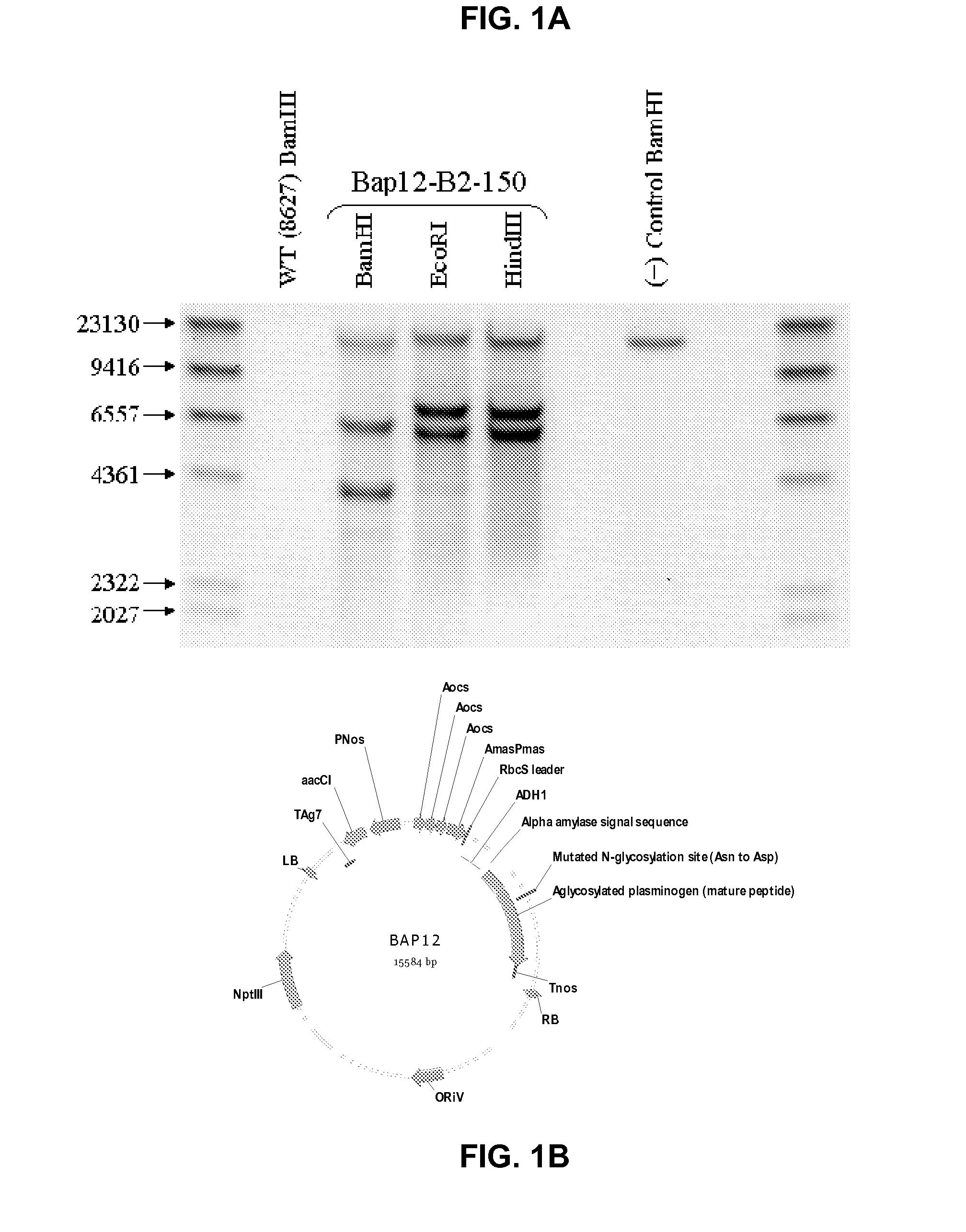Compositions and methods for production of aglycosylated plasminogen
a technology of plasminogen and aglycosylated plasminogen, which is applied in the field of compositions and methods for producing aglycosylated plasminogen in plants, can solve the problems of inactive human plg expression, large difficulty in expressing stable human plg, degradation of plg, etc., and achieve the effect of increasing production and yield
- Summary
- Abstract
- Description
- Claims
- Application Information
AI Technical Summary
Benefits of technology
Problems solved by technology
Method used
Image
Examples
example 1
Improved Recovery of PLG from Duckweed by Use of a Human, Aglycosylated PLG
[0211]Recombinant human plasminogen (PLG) has previously been produced in Lemna, a member of the duckweed family (see U.S. Patent Application Publication No. 20050262592, the contents of which are herein incorporated by reference in their entirety). The collected PLG product can be fully activated to an aglycosylated human plasmin for use in a variety of clinical indications, as noted elsewhere herein. It has been discovered that improved recovery of stable PLG from the duckweed expression system is possible when the PLG protein structure is altered such that N-linked glycosylation at Asparagine (Asn)-289 of the mature human PLG sequence is prevented. In this manner, the coding sequence for human PLG was modified to include a codon for an aspartic acid residue in place of Asn-289 to prevent attachment of the typical plant N-linked glycan at this position of the mature PLG protein (see N289D protein sequence s...
example 2
Comparison of Plasminogen Yield from BAP01-B2-230 and BAP12-B2-150 Transgenic Lines
[0306]Yield of full-length (not truncated) mature plasminogen from the transgenic Lemna line expressing mature human PLG with the Asn-289 N-glycosylation site (BAP01-B2-230) and the transgenic line expressing mature human PLG with the N289D substitution was compared under varying culture conditions and culture times. The results are shown in FIGS. 18 and 19. Transgenic line BAP01-B2-230 was cultured for 21 days (bar A in FIGS. 18 and 19) or 28 days (bar B in FIGS. 18 and 19) at 24.5° C. in passive vented SV. Transgenic line BAP12-B2-150 was cultured for 28 days (bar C in FIGS. 18 and 19) at 24.5° C. in passive vented SV, or for 21 days (bar D in FIGS. 18 and 19) or 33 days (bar E in FIGS. 18 and 19) in a vented FASV at 21° C. Yield of full-length mature PLG in mg per kilogram fresh weight of tissue or yield in mg per growth vessel are shown under the various culture conditions in FIG. 18 and FIG. 19, ...
example 3
Demonstration of Fibrin Binding of BAP12-B2-150 Plasmin
[0310]Fibrin binding of the aglycosylated plasminogen is indicated by binding to Lysine Sepharose. Lysine Sepharose is routinely used for kringle domain containing proteins. Confirmation of fibrin binding is determined in one of two ways. A direct binding affinity measurement is obtained via the use of Biacore with a fibrin-coated chip. A similar experiment is run in a microtiter plate containing fibrin. In this study, aglycosylated plasminogen from transgenic line BAP12-B2-150 is applied to the plate and unbound protein is washed away. Fibrinolysis is then measured by activation of the aglycosylated plasminogen to aglycosylated plasmin. Only plasminogen bound to the fibrin is available to lyse the fibrin clot. A comparison is made to glycosylated PLG from transgenic line Transgenic line BAP01-B2-230.
[0311]The BAP12-B2-150 plasmin shows fibrin binding similar to that of the glycosylated BAP01-B2-230 plasmin, even in the absence ...
PUM
| Property | Measurement | Unit |
|---|---|---|
| molecular weight | aaaaa | aaaaa |
| concentrations | aaaaa | aaaaa |
| temperature | aaaaa | aaaaa |
Abstract
Description
Claims
Application Information
 Login to View More
Login to View More - R&D
- Intellectual Property
- Life Sciences
- Materials
- Tech Scout
- Unparalleled Data Quality
- Higher Quality Content
- 60% Fewer Hallucinations
Browse by: Latest US Patents, China's latest patents, Technical Efficacy Thesaurus, Application Domain, Technology Topic, Popular Technical Reports.
© 2025 PatSnap. All rights reserved.Legal|Privacy policy|Modern Slavery Act Transparency Statement|Sitemap|About US| Contact US: help@patsnap.com



